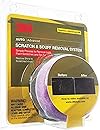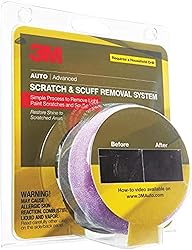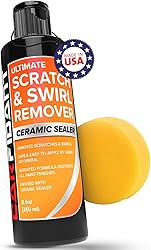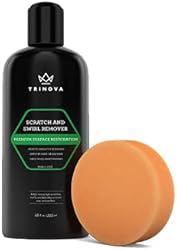It’s amazing how fast a perfect paint job can go from flawless to frustrating. One careless swing of a door, a stray shopping cart, or a low-hanging branch — and suddenly there’s a mark staring back at you every time you walk by your car.
But before you reach for touch-up paint or call the body shop, one of the Best Car Scratch Removers might be all you need to save your finish and your wallet. I’ve tested the most popular options to see which ones actually deliver — and which ones just shine things up without fixing a thing.
Best Car Scratch Removers in 2025
| Image | Model | |
|---|---|---|
 | Best Overall Kit Meguiar’s Scratch Eraser KitEditor's Choice | Check Price |
 | Best for Deeper Repair 3M Scratch Removal System Check Price | Check Price |
 | Best for Moderate Swirl Correction Chemical Guys VSS Remover Check Price | Check Price |
 | Best for Quick Hand Use Carfidant Scratch Remover Check Price | Check Price |
 | Best for Machine Polishing Griot’s Complete Compound Check Price | Check Price |
 | Best for Quick Cosmetic Fixes TriNova Swirl Remover Check Price | Check Price |
 | Best for Beginners with Light Scuffs Torque Detail Remover Check Price | Check Price |
- For light surface defects like swirls and minor scuffs, this car-friendly scratch remover offers a reliable combination of cutting power and usability — making Meguiar’s Quik Eraser Kit a solid all-around choice.
- For more aggressive clear coat damage, 3M’s multi-step system offers deeper correction, but requires time and precision to avoid mistakes.
- Griot’s Garage Complete Compound shines when paired with a dual-action polisher — it’s the pick for paint restoration, not just scratch repair.
- Always match the product to the damage depth: light fillers won’t fix deep gouges, and strong compounds may dull a healthy finish if misused.
- Don’t skip prep — clean panels and proper technique make the difference between a temporary shine and a real fix.
1. Meguiar’s Quik Scratch Eraser Kit
Meguiar’s knows how to make products that just work — and this scratch kit is one of them. It comes with a drill-mounted pad, a microfiber cloth, and a small bottle of compound. I used it on a handful of clear coat scratches and parking lot scuffs, and it made quick work of them.
The magic here is in the combo: the compound cuts just enough to remove light-to-moderate blemishes, and the foam pad mounted to a cordless drill makes the job fast and even. The included microfiber towel isn’t anything fancy, but it gets the job done.
It won’t fix deep gouges or primer-level damage, but for the typical swirls, scuffs, and fingernail scratches near door handles, this thing is money. Just don’t expect miracles — use it on the right damage and it’ll feel like one.
Pros:
- Includes drill pad and towel — ready to use out of the box
- Removes light-to-moderate scratches quickly
- Works fast with power tool assist
Cons:
- Small bottle — easy to run out if overused
- Not for deep scratches
2. 3M Scratch Removal System
The 3M kit is more than a simple scratch remover — it’s a full three-step system, and it shows. You get abrasive pads, compound, and polish, all designed to take you from ugly scuff to polished panel. And yes, it’s more effort than a one-step cream, but it’s also way more effective.
I tested it on a scratch that ran along the quarter panel from a rogue branch. It wasn’t into the primer, but definitely more than just a surface blemish. After using the kit step-by-step, I had to double-check where the scratch used to be.
Just know what you’re getting into — this isn’t a wipe-and-forget product. You’ll need patience and careful attention. But if you’re willing to do it right, the results speak for themselves.
Pros:
- Multi-stage approach for real paint correction
- Works on deeper clear coat scratches
- Professional-style results at home
Cons:
- Time-consuming compared to simple pastes
- Can damage paint if used incorrectly
3. Chemical Guys VSS Scratch & Swirl Remover
This isn’t your average scratch filler — VSS is a hybrid polish that works well when you give it time to cut and work the surface. I used it with both a dual-action polisher and by hand, and while the results took more effort, it absolutely improved swirl marks and light defects.
What I like most is the versatility. You can use it on clear coat, glass, even plastic headlights. It doesn’t leave greasy residue and buffs clean. If you’re chasing that deep gloss on darker paint, VSS helps bring it back.
Don’t expect it to wipe away scratches in one pass — it’s not that kind of product. But if you’re willing to spend some time working it in, it delivers.
Pros:
- Removes swirl marks and hazing
- Works on many surfaces — paint, plastic, even glass
- No oily mess or leftover haze
Cons:
- Needs polishing tool for best results
- Not ideal for deep scratches
4. Carfidant Scratch and Swirl Remover
This one’s built for speed. No need for polishers or drills — just apply with the included pad and wipe off. I tested it on several hairline scratches near door handles and on a fuel cap. It took a couple of passes, but they faded significantly.
The texture feels creamy but has enough bite to cut light oxidation and scuffing. It’s not ideal for anything too deep, but for a quick fix before a car meet or resale photo shoot, it works.
If you’re new to scratch removal, this one is a good starting point. It’s forgiving, simple, and doesn’t require any extra tools.
Pros:
- Beginner-friendly and fast to use
- Safe for most surfaces, including clear coat
- Includes application pad
Cons:
- Temporary effect on deeper scratches
- Not ideal for long-term correction
5. Griot’s Garage Complete Compound
This isn’t some casual wipe-on product — Griot’s Complete Compound is a serious polish for people who know what they’re doing. When used with a dual-action polisher, it levels out oxidation, removes medium-depth scratches, and leaves a glass-like shine behind.
The formula spreads smoothly and doesn’t dust much, which I appreciate when working in a closed garage. It’s not overly aggressive, but still cuts deep enough to restore tired paint. Great for those doing full paint correction or restoring neglected panels.
If you’ve got a buffer and want to make paint pop again — this is the bottle to grab.
Pros:
- Professional-grade correction with a polisher
- Restores gloss and clarity
- Low dust, easy cleanup
Cons:
- Less effective by hand
- Overkill for light swirls
6. TriNova Scratch Swirl Remover
TriNova markets this one as an all-in-one swirl and scratch remover, and it’s honestly a mixed bag — depending on what you expect. It’s super easy to apply, even by hand, and the immediate visual result is impressive. Light swirls practically vanish with just a microfiber pad.
But here’s the catch: the effect often doesn’t last long. It tends to fill or mask scratches rather than truly remove them. After a wash or two, some of those marks can reappear. It works best as a cosmetic touch-up for minor clear coat scuffs.
Still, I’d keep this on the shelf for last-minute detailing or pre-sale cleanups. Just know that it’s more of a cover-up than a correction tool.
Pros:
- Easy to apply by hand
- Visibly improves finish right away
- Great for quick detailing sessions
Cons:
- Temporary results in many cases
- Not a true remover for deeper scratches
7. Torque Detail Reverse Scratch Remover
This product promises to remove scuffs without effort, and to its credit, it’s very user-friendly. No tools, no multi-step routines — just apply and wipe. I tested it on clear coat blemishes from light contact with foliage and fingernails near the door handle. The marks didn’t disappear completely, but they were definitely reduced.
It doesn’t bite as deep as a proper compound, so don’t expect miracles. But the upside is it’s almost impossible to mess up — perfect for those who want safe results without overthinking the process.
I’d say it’s one of the better “wipe-on” formulas out there, just not for anything too aggressive.
Pros:
- Extremely easy to use
- Safe for all paint finishes
- No risk of over-polishing
Cons:
- Not effective on deeper scratches
- Needs reapplication over time
Buyer’s Guide: How to Choose the Right Car Scratch Remover
Not all scratches are equal — and not all scratch removers are worth your time. I’ve worked on everything from showroom paint to faded clear coat, and here’s what actually matters when picking a product that does more than just shine up the problem.
Why It Matters
Besides making your car look like it just brushed against a shopping cart war zone, scratches can lead to oxidation, rust, and a serious dip in resale value. The right remover not only improves looks — it can delay much costlier repairs down the road.
Types of Car Scratch Removers
Some products are glorified wax. Others actually cut into the clear coat to smooth the surface. Here’s a quick breakdown:
| Type | Use & Characteristics |
|---|---|
| Creams & Pastes | Great for light scuffs and swirl marks. Usually applied by hand with a microfiber towel. |
| Scratch Kits with Pads | Better for deeper marks. Often come with drill attachments or foam applicators for faster correction. |
| Polishing Compounds | Remove oxidation, water spots, and light-to-moderate scratches. Sometimes dual-purpose with waxes. |
| Rubbing Compounds | Abrasive formulas for deeper defects. Effective but should be used carefully — they cut fast. |
How to Know What You Need
Run your fingernail over the scratch. If it catches, you’re dealing with something that likely needs a more aggressive approach — maybe a pad-and-polish kit or even professional help. If it glides over smoothly, a simple cream should do the job.
Other Features to Look For
Check that the remover is safe for your paint type — especially if you’ve got metallic or matte finishes. Some products come with everything you need (applicators, cloths, instructions), while others are just paste in a bottle. Also, look at the abrasive level: a medium-cut polish might be perfect for average scuffs, but overkill for light swirl marks.
Application Tips That Actually Matter
Always start on a clean surface. A quick wash isn’t enough — make sure there’s no grit or dust that could cause more damage while you work the remover in. If you’re using a machine polisher, take your time and let the tool do the work. Always finish by wiping clean with microfiber.
Common Mistakes I’ve Seen (and Made)
Don’t use heavy-duty compounds on light scratches — you’ll risk hazing or dull spots. Also, don’t assume one product fits all: paint types vary, and so do scratch depths. And never apply to a dirty surface — that’s a recipe for new problems.
Price vs. Performance
You don’t need to spend $50 to get decent results, but there’s a line: ultra-cheap products often fill in scratches temporarily rather than removing them. If you’re dealing with repeated issues or a lot of clear coat damage, a quality kit with pads is a better long-term investment.







